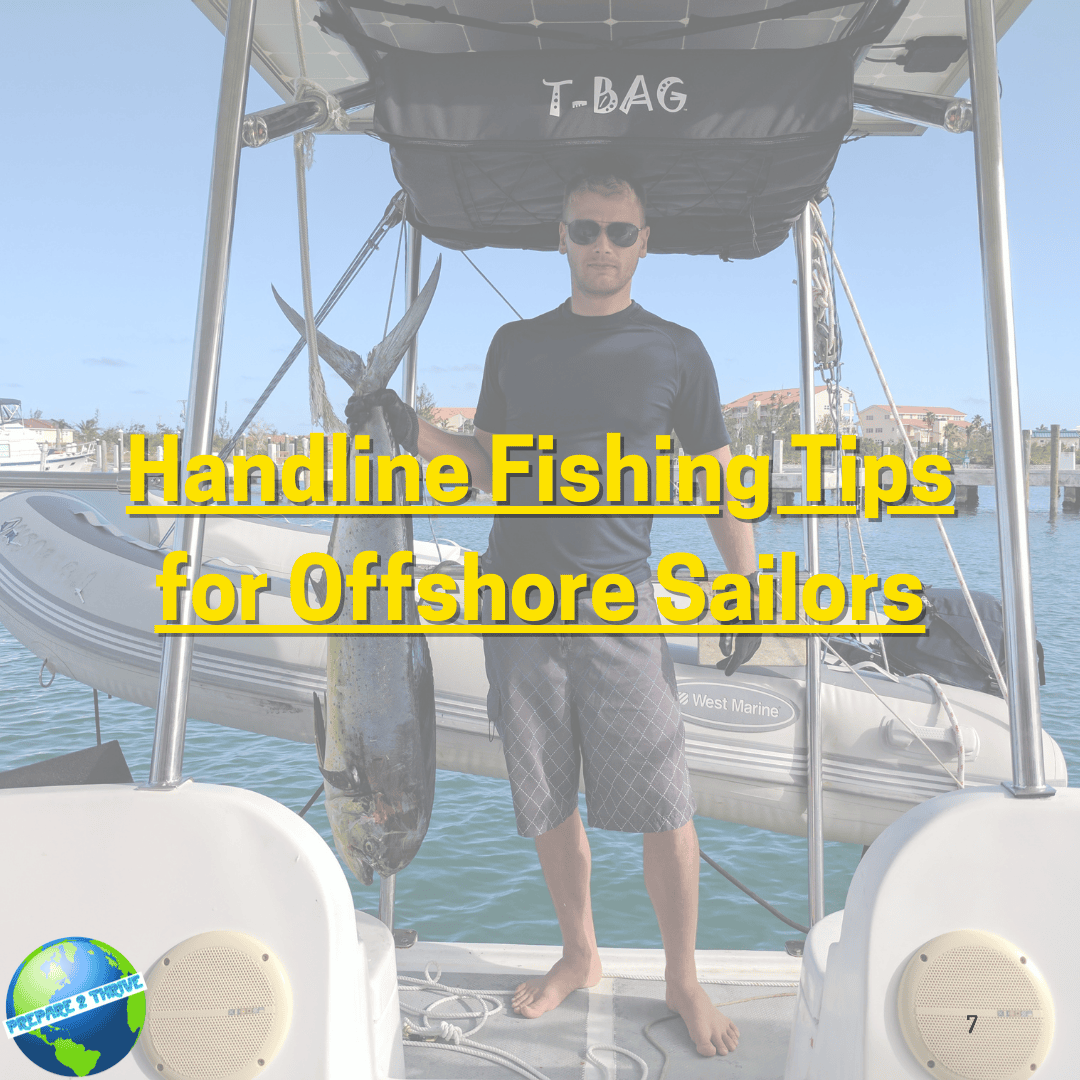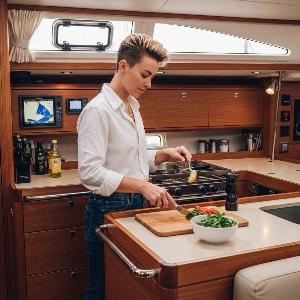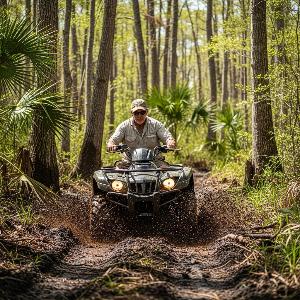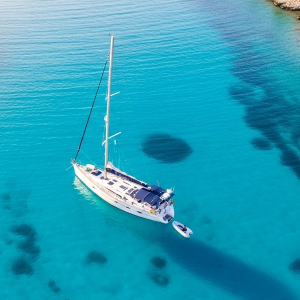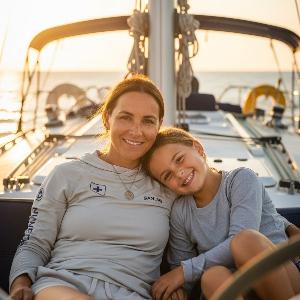Handline fishing is a skill that all other cruising sailors should acquaint themselves with.
Don't be put off by the word 'handline' - you don't have to hold it all the time. Just wait until a hooked fish announces its predicament, then haul it in.
We're not talking about sport fishing here - sailboat fishing is all about catching fish to eat.
And there's more good news...
You won't need any expensive rods and reels.
Handline fishing gear is simple, robust and inexpensive.
Once you've tasted your first handline-caught fish - whether caught while sailing offshore or at anchor - I'm pretty sure you'll agree that the investment was cheap indeed.
A Handline Fishing Rig for Sailing Offshore
Here's the basic gear, a simple handline fishing rig for trolling offshore...

Just 100 feet (30m) of 300lb main line, a snap swivel and a further 20 feet (7m) of 300lb leader attached to a skirted trolling lure.
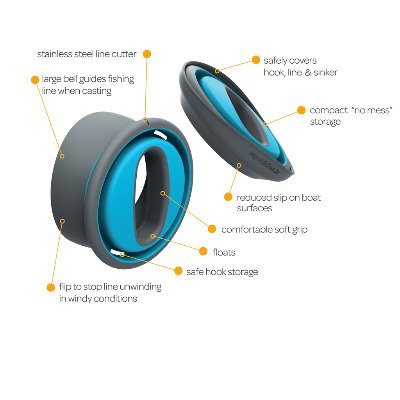
Your line can be stored safely on "Cuban Yoyos". On our catamaran we use Squiddies Flip Reels available at Amazon. They are available in 4 colours so you can match the line length to the colour.
You won't be able to tie secure knots in this heavy line; only crimped connections will hold under load.
Note that the trolling weight on the main line is optional - only use it if the lure skips along the surface and refuses to submerge. For best results the lure should 'swim' a few feet below the surface, but should break the surface every few seconds before submerging again.
Look for the bubble trail streaming out from the lure. This is the sign of a good, fish-catching lure as it's this that creates 'noise' in the water and attracts the fish to your lure.
Whatever type of trolling lure you use for handline fishing, remember to check it now and again to remove any flotsam it may have picked up, redeploy it and await the arrival of Neptune's bounty.
Use a Snubber Line for Handline Fishing

Artwork by Andrew Simpson
This is an essential addition to any trolling handline. The 'snubber' is the bungee cord; it acts as a shock absorber and will prevent the fish from tearing itself free of the hook when it first realises it's in a spot of bother. It also lets you know when you've got a fish. If it's fully extended, get pulling!
Stay Safe!
Ocean fish are fast, powerful creatures and in their struggle to get free they will use every ounce of their considerable energy. So, a few safety rules when handline fishing:
- Always use tough gloves when hauling in the fish and never, ever take a loop of line around your hand;
- When hauling in a fish, be careful not to step into the loops of line that will accumulate in the cockpit. OK, the fish on the end of the line may not be enormous but the one that grabs it just might be!
- Always have a sharp knife to hand, just in case;
- A large, hugely agitated freshly caught fish leaping around in the cockpit is at its most dangerous. Place a wet towel over it to calm it down, and pour some strong alcohol (not your best malt whisky - the cheapest firewater will do the trick) in its gills to accelerate its passing;
- Wait until the fish is dead before attempting to unhook it.
Double or Quadruple Your Chances!
On a monohull? Why not use two trolling handlines, one from each quarter? On a catamaran? You can use 4 trolling lines at once! Make one around 30 meters long and each additional line should be a little longer, say an extra 10 meters and use a different type of lure. As soon as you get a strike on one, bring the others in, as two fish on at once will almost certainly lead to a major tangle - and no fish at all.
The longer lines should be on the leeward side, which will help to space them apart.
What will My Handline Fishing Rig Catch?
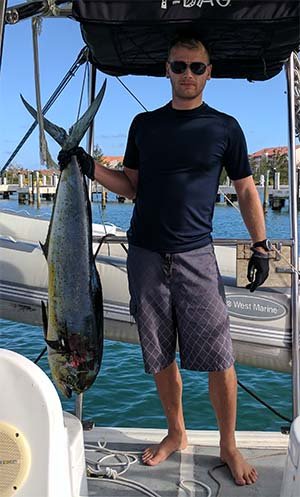
In warm ocean zones these handline fishing rigs will catch the fish that hunt their prey close to the surface - tuna, wahoo, dorado, kingfish, barracuda, mackerel, jacks etc.
And having caught your fish, you'll need to know how to kill it humanely, clean it and prepare it for cooking.
Ideally, your catch will be around the size of the dorado shown here, but now and again you may hook one of the oceans' great billfish, a sailfish or a marlin for example.
The odds are that you won't get it to the boat - nor would you want to, I'm guessing. But if you do, please unhook it and release it if you can, or cut the line close to the mouth of the fish and let it swim free if you can't.
They're just too magnificent a creature to kill, and they're not the best tasting fish in the sea.
Although these huge fish will take a small lure, they're more likely to ignore it than they would a large one.
So unless you want to do battle with an ocean gamefish, it's a good idea when sailboat fishing to use lures that don't exceed 8 inches (200mm) or so in overall length.
Top Tip #1 - Try a Teaser!
Fish get very excited when they detect a shoal of baitfish splashing around on the surface. You can replicate this activity by towing a splashy object a few feet in front of your lure. A half-filled plastic bottle works well, as does a net bag full of wine bottle corks.
If you're using two trolling handlines, one from each quarter, tie the teaser line to the backstay and make sure that all the splashing takes place a few feet ahead of the lure that's closest to the boat. This deception is probably the most effective way of getting fish to take an interest in your lures.
Top Tip #2 - Rig Up a Daisy Chain!
 Even more alluring - a daisy chain rig for an offshore trolling handline.
Even more alluring - a daisy chain rig for an offshore trolling handline.And you can also create more noise with a daisy chain.
A low-cost version can be made up by positioning a few plastic squid skirts along the leader at around 3 foot intervals, each one separated from the other by an overhand knot (or better, a crimp) and a bead.
Only the lure at the end of the line sports a hook; the others are merely decoys.
But what are the best saltwater trolling lures for sailboat fishing?
